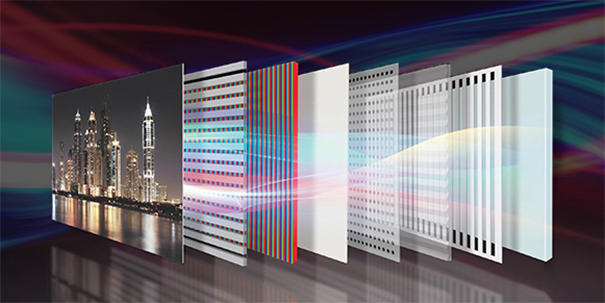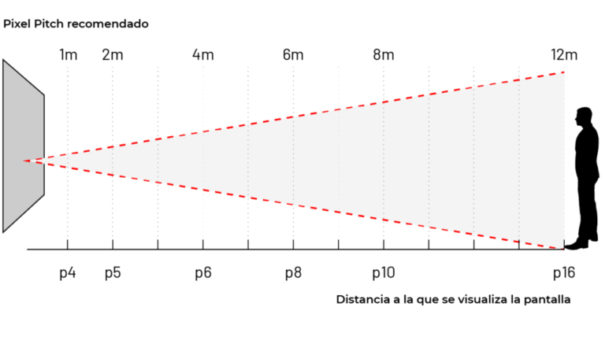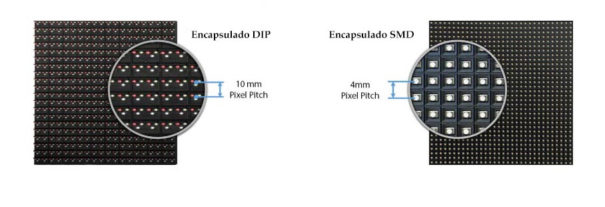How to choose a Led screen? Selection criteria
En este artículo, LED&Go explica los elementos a tener en cuenta en un proyecto a la hora de elegir una pantalla Led y que atienden al brillo, Pixel pitch, dimensiones, transparencia y encapsulado.
Las pantallas Led son una herramienta indispensable en proyectos de publicidad de gran formato pero además se consideran soluciones tecnológicas que encajan en todo tipo de espacios y aportan un valor añadido a muchos sectores (communication, ocio, retail, Shows, etc).
Hacer una selección adecuada de la tecnología es clave para un resultado de calidad. LED&Go pone de manifiesto en este artículo cuáles son los criterios que se tienen que tener en cuenta para saber qué tipo de pantalla Led es la más adecuada para el proyecto que se quiere realizar: brightness, Pixel pitch, dimensiones, transparencia y encapsulado.
Brillo
Medido en nits o candelas/m2, el brillo de una solución Led representa la potencia lumínica que el soporte emite. El valor del brillo se calcula para contrarrestar la incidencia de luz natural sobre la cara de reproducción del soporte y puede variar desde los 1.800 (baja incidencia o nula) hasta los 10.000 Nits (incidencia directa).
Consecuentemente, el brillo va directamente relacionado con la ubicación de la pantalla. Si es en exterior deberá rondar los 5.500 Nits; por el contrario, si es de interior, variará entre los 1.000 and the 2.000 Nits. Existe un tercer tipo de pantalla, según ubicación, son las llamadas híbridos pues se trata de equipos ideados para soluciones en las que reciben incidencia de la luz natural pero no se encuentran en el exterior, como puede ser el caso de escaparates. En este último caso el brillo debe variar entre los 2.000 and 4.000 Nits.
Es muy importante regular adecuadamente el brillo para la correcta visualización de los contenidos en una pantalla Led, aunque mientras más potencia lumínica se requiera más rápido disminuirá la vida útil de la pantalla aunque esto depende de otros muchos factores.
Las pantallas Led de exterior deben estar diseñadas para resistir las condiciones atmosféricas del lugar. Esto implica que estarán formadas con paneles de alta permeabilidad y contar con protección para exterior. Estas características pueden aumentar el precio, sin embargo las pantallas de exterior no requieren normalmente tanta resolución como las de interior equilibrando así su precio.
Pixel Pitch
El píxel pitch representa la separación física entre Led, asociado de forma directa a la resolución del soporte (a menor píxel pitch mayor resolución y viceversa). La distancia de visionado es el punto de partida para definir el píxel pitch de la solución.
To do this,, se toma en consideración la distancia mínima de visionado del público objetivo y se realiza el diseño de la solución ideal para la correcta visualización del soporte.
Cuanto más cerca de los espectadores se encuentre la pantalla Led mayor resolución debe tener y, therefore, un pitch bajo. However, no siempre se precisa un pixelado más pequeño. En soluciones en las que el espectador siempre observará la pantalla a grandes distancias resulta innecesario y supone un gasto de dinero que no aportará beneficio.
Dimensions
En Led&Go hacen cada diseño de pantalla Led personalizado y, en términos de diseño e ingeniería, las dimensiones de la pantalla son un factor a tener en cuenta muy importante.
La solución debe idearse adaptándola a las dimensiones de la ubicación y a las medidas base de los módulos Led. Cada tecnología tiene dimensiones estandarizadas que van de la mano con la optimización de los elementos eléctricos y electrónicos.
Para proyectos con alto grado de personalización, los módulos Led son hechos a medida. Esta selección de módulos es un valor añadido que aumentará su coste.
Económicamente el tamaño de la pantalla Led no implica directamente mayor precio, pues el valor de coste se estructura según la tecnología a utilizar y la cantidad de la misma. Se puede tener una pantalla de 4×2 metros con una resolución baja, que ronde por ejemplo los 15.000 px/m2, que cueste lo mismo que otra de 2×1 metros con alta resolución, approximately 60.000 px/m2.
Transparencia
Existen soluciones a las que se les puede aplicar cierto grado de transparencia, ya sea creando espacios entre los Led o mediante el uso de módulos cuyo material de fabricación sea traslúcido. Para estas opciones se considera la necesidad del cliente de ver a través de la pantalla o permitir el paso de luz natural a través de ella.
Encapsulado Led
El encapsulado de las soluciones Led va asociado al tipo de integración de las bombillas sobre la placa base o módulo. En función del encapsulado, las soluciones varían entre dos presentaciones: DIP y SMD.
En el primer caso cada color del sistema RGB está representado por una bombilla Led. Al tener las tres bombillas independientes tiene como resultado mucho más brillo. Su inconveniente es que no permite utilizarse en soluciones con muy alta resolución.
SMD integra en un mismo Led los tres colores del sistema RGB (rojo, Green and blue), permitiendo resoluciones más pequeñas, pero menos brillo. Esta se suele utilizar en interior y el encapsulado DIP para exterior, aunque no siempre es así.
You liked this article?
Subscribe to our Feed And you won't miss a thing.

















